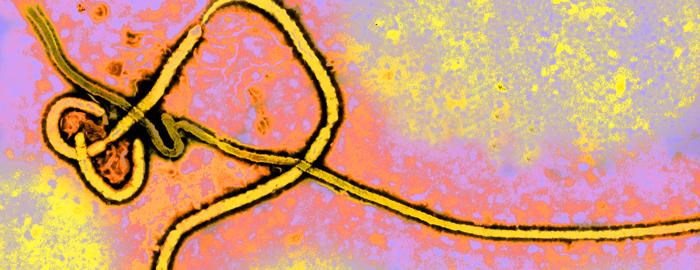New breakthrough paving the way for universal Ebola therapeutic

This is an Ebola photomicrograph. Credit: The University of Texas Medical Branch at Galveston
The Ebola virus causes a severe illness with high mortality rates in humans. Several strategies have been developed to treat Ebola infection, including ZMapp, which has been shown to be effective in non-human primates and has been used under compassionate-treatment protocols in humans.
“The trouble with ZMapp is that although it is effective against the Ebola species that was largely responsible for the last Ebola outbreak, it does not neutralize other Ebola species, including Ebola Bundibugyo, Reston or Sudan,” said virologist Alex Bukreyev, co-senior author and a University of Texas Medical Branch at Galveston professor in the department of pathology.
“We identified and studied three naturally-occurring antibodies from human survivors of Ebola Bundibugyo that neutralize and protect against infection with the several different Ebola virus species.”
The newly identified antibodies bond at a different site on the Ebola virus than other antibodies currently used to develop Ebola therapies.
Information on the Ebola virus:
According to the Centers for Disease Control, Ebola was first discovered in 1976 near the Ebola River in what is now the Democratic Republic of Congo. Since then, the virus has been infecting people from time to time, leading to outbreaks in several African countries.
Some of the different kinds of Ebola viruses are:
- Ebola virus (Zaire ebolavirus)
- Sudan virus (Sudan ebolavirus)
- Taï Forest virus (Taï Forest ebolavirus, formerly Côte d'Ivoire ebolavirus)
- Bundibugyo virus (Bundibugyo ebolavirus)
- Reston virus (Reston ebolavirus), known to cause disease in nonhuman primates and pigs, but not in people
Other authors include UTMB's Natalia Kuzmina, Philipp linykh, Xiaoli Shen, Kai Huang, Palaniappan Ramanathan, Thomas Ksiazek and Alexander Bukreyev; Andrew Flyak, Pavlo Gilchuk, Christopher Gulka, Rebecca Lampley, Nurgun Kose, Hannah King, Gopal Sapparapu, David Wright and James Crowe, Jr. from Vanderbilt University; Charles Murin, Hannah Turner, Marnie Fusco, Erica Ollmann Saphire and Andrew Ward from The Scripps Research Institute as well as Christopher Bryan, Edgar Davidson and Benjamin Doranz from Integral Molecular, Inc.
The study was supported by the Defense Threat Reduction Agency and the National Institutes of Health.
Media Contact
More Information:
https://www.utmb.edu/newsroom/article11767.aspxAll latest news from the category: Health and Medicine
This subject area encompasses research and studies in the field of human medicine.
Among the wide-ranging list of topics covered here are anesthesiology, anatomy, surgery, human genetics, hygiene and environmental medicine, internal medicine, neurology, pharmacology, physiology, urology and dental medicine.
Newest articles

High-energy-density aqueous battery based on halogen multi-electron transfer
Traditional non-aqueous lithium-ion batteries have a high energy density, but their safety is compromised due to the flammable organic electrolytes they utilize. Aqueous batteries use water as the solvent for…

First-ever combined heart pump and pig kidney transplant
…gives new hope to patient with terminal illness. Surgeons at NYU Langone Health performed the first-ever combined mechanical heart pump and gene-edited pig kidney transplant surgery in a 54-year-old woman…

Biophysics: Testing how well biomarkers work
LMU researchers have developed a method to determine how reliably target proteins can be labeled using super-resolution fluorescence microscopy. Modern microscopy techniques make it possible to examine the inner workings…





















